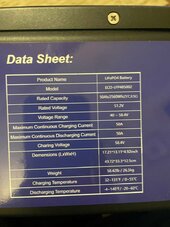I'm using 4x DC house 48v 50Ah batteries in parallel.
According to their specs:
Charging voltage: 58.4v
Operating range: 40-58.4v
1. How should I setup XP parameters according to this?
2. How does the XP keep track of SoC without communicating?
3. Is it possible to limit solar charge at 80% of Soc?
Thank you.
According to their specs:
Charging voltage: 58.4v
Operating range: 40-58.4v
1. How should I setup XP parameters according to this?
2. How does the XP keep track of SoC without communicating?
3. Is it possible to limit solar charge at 80% of Soc?
Thank you.




